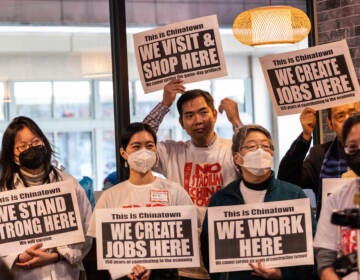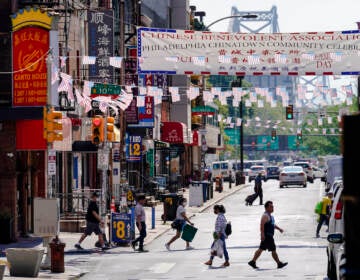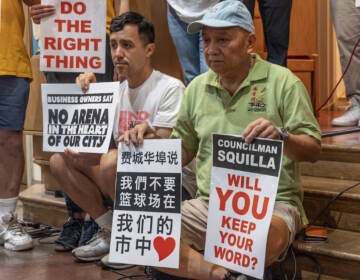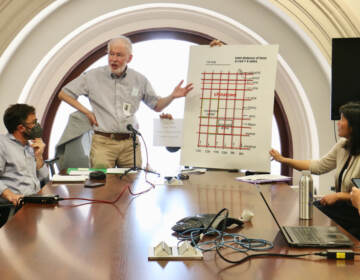The city has finally released its Sixers arena impact studies. Here’s what they say
The four analyses are expected to help stakeholders weigh the value of building a privately funded basketball arena in Center City.
Listen 11:57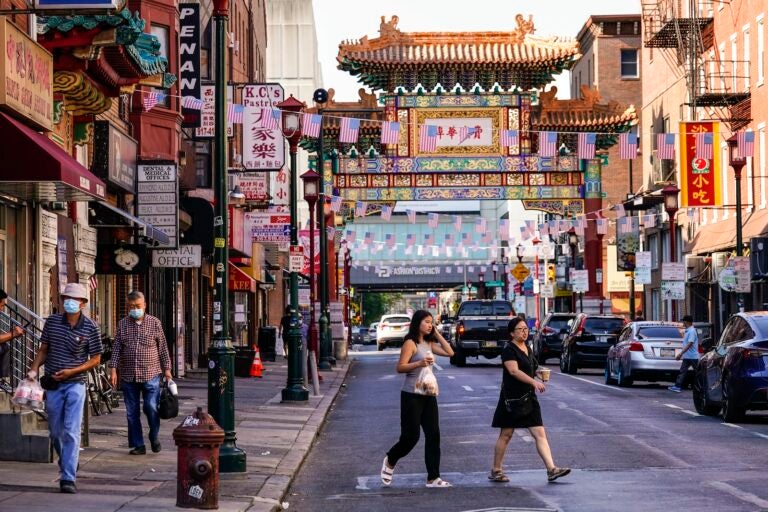
Pedestrians cross 10th Street in the Chinatown neighborhood of Philadelphia, July 22, 2022. (AP Photo/Matt Rourke, File)
What you need to know
- The 76ers have proposed moving to a new $1.55 billion arena near Chinatown called “76 Place”
- The proposal has drawn swift condemnation, excitement, skepticism — and plenty of buzz
- Black Clergy of Philadelphia has endorsed the project, while a majority of Chinatown businesses and other community members have voiced their opposition
- Amid competing interests, the arena’s future remains uncertain
For more than two years, residents and business owners in Chinatown have called the Sixers’ arena proposal an “existential threat” to the neighborhood.
Consultants hired to independently evaluate the impact of the $1.55 billion project have reached a similar but less certain conclusion, saying in a new study that the controversial development “could potentially result in the loss of Chinatown’s core identity and regional significance.”
Released late Monday, the analysis raises concerns about increased traffic congestion as well as the potential for displacement as a result of increased property values.
“Although the project will not lead to direct housing displacement, there is evidence for increased indirect displacement of small businesses and low- and fixed-income individuals through gentrification and loss of cultural identity in Chinatown if the 76 Place were built,” researchers concluded.
The findings are part of a long-awaited study commissioned by the city — one of four analyses expected to guide officials weighing the value of building a new Sixers arena in Center City near Chinatown, including Mayor Cherelle Parker and City Councilmember Mark Squilla, whose district includes the proposed site.
Eight months past its original deadline, the city has released a community impact assessment, an economic impact analysis, a design consulting, and a traffic, transportation and parking analysis. Consultants were not “expected to provide specific recommendations for or against the arena proposal, but to provide independent, neutral evaluations,” according to a news release from the Parker administration.
The studies, which were bankrolled by the Sixers, were released shortly after Parker privately discussed the proposal with community leaders from Chinatown, and about 10 days before City Council returns from summer recess. Parker has yet to publicly back or oppose the development, which cannot proceed without zoning approvals. Lawmakers have also largely kept quiet.
The Sixers hope to start vertical construction on the 18,500-seat arena in 2028 and open the privately funded facility in 2031, the same year its lease expires at the Wells Fargo Center in South Philadelphia.
The team says the project would help rebuild and repair the blocks east of City Hall, a disjointed stretch of shops, government buildings and tourist attractions that has floundered even as nearby neighborhoods have flourished. The report found the arena’s impact on Market East to be “inconclusive.”
Room for 2 arenas?
While the community impact study includes findings that may bolster opposition to the project, consultants reached other conclusions that could be used to make a case for building the arena.
The economic impact analysis, conducted by Conventions, Sports & Leisure (CLS), found that the Philadelphia metro can support “multiple professional arenas” and that both arenas would ultimately be “financially viable.” The Wells Fargo Center would likely be negatively impacted by the construction of a new arena, however, when it comes to suite revenue generation, naming rights and the loss of Sixers games, according to CLS.
Comcast Spectacor, which owns and operates Wells Fargo, has argued the region cannot support two arenas, particularly when it comes to non-basketball programming, a claim the Sixers reject. The company, which has plans to reimagine part of the stadium district, is trying to persuade the Sixers to remain at Wells Fargo.
“We’ll both be vying for the same acts. That’s why we believe it would be in their best interest, and our best interest, for us to find a way to do this together,” said Daniel Hilferty, chairman and CEO of Comcast Spectacor, told WHYY News in October.
The economic study also found that a new Sixers arena would generate about $1.9 billion in additional economic activity during construction and its 30-year lifespan. The report says that would result in $390 million in net new tax revenue for the city, its school district and the state — far less than the estimated $1.5 billion the Sixers officials have said would be generated if the team moved to Center City.
The Sixers, who argue the report’s cost estimation method cannot be used for an “apples-to-apples” comparison, appear to be encouraged by the economic findings and the analyses overall. For example, design consultants concluded the arena is “appropriate for Center City Philadelphia.” The traffic report found that the Sixers’ hopes of having 40% of fans travel to the arena via public transportation are “attainable,” and that there is “sufficient garage parking” in the vicinity of the arena to meet the expected demand from drivers.
While the vast majority of fans drive to the Wells Fargo Center, the team expects most fans to use public transportation, get dropped off by an Uber or taxi or walk to the new arena. Fans who do drive are expected to use existing parking garages.
“We are reviewing what has been released and we will have more to say when we are able to complete a full analysis, but it is clear already that they support what we’ve said since we first announced 76 Place: the arena is an appropriate use for Center City and will generate significant new jobs and tax revenue because Philadelphia can support two arenas. Our parking and traffic assumptions are achievable and these findings are more evidence that 76Place can be developed in a way that protects our neighbors and maximizes benefit to Philadelphia,” said a spokesperson for 76DevCo, the team’s development arm, in a statement.
Sixers arena fears persist
Opponents of the arena proposal remain concerned.
Since the Sixers announced the team’s plans for a new arena, critics have raised concerns about traffic during home games and other events such as concerts. They worry the area in and around Chinatown will become so congested on those days that people will avoid the neighborhood altogether. The argument is part of a broader fear that the arena project will destroy Chinatown, a 150-year-old ethnic enclave.
Members of the Save Chinatown Coalition say the impact studies are self-serving and do nothing to calm anxieties that a downtown arena would inflict irreparable harm on an irreplaceable community.
“Let’s be clear: Billionaire developers will benefit the most from 76 Place, and these studies are window dressing to obscure that fact. Don’t fall for it,” said Rev. Greg Edwards, executive director of POWER Interfaith, in a statement.
JC Bradbury, an economics professor at Kennesaw State University, said impact studies typically overstate the benefits sports arenas can have on downtowns, in part because they are forward-looking and usually discount what has happened in the past with similar projects.
In most cases, said Bradbury, economists have found that arenas and stadiums are not the economic engines developers say they are.
“This is sort of your old con — like the Music Man or Lyle Lanely and the monorail on The Simpsons. It’s just sort of ‘how can we convince you that this is a good idea?’ and then once it’s implemented we can walk away from it,” said Bradbury.
An analysis released in February found that 76 Place could cost Philadelphia and Pennsylvania more than $1 billion in lost tax revenue, a scenario that would nearly offset the public revenues the team says a downtown arena would generate.
“A lot of studies that are made to support any new project, they take into account what jobs and what activities are created by the investment, but they don’t really take into account the substitution effect. The fact that you’ll have customers who have gone to an existing restaurant that will then go to that new restaurant,” said economist Arthur Acolin, the Bob Filley Endowed Chair in the Department of Real Estate at the University of Washington.
The first session of City Council is Sept. 5. Squilla, who would introduce any enabling legislation needed for the arena, said Tuesday on WHYY’s “Studio 2” that he wants to get those bills out “as soon as possible” to give residents ample time to review them. He has vowed to share copies of the proposed measures with constituents at least 30 days before he would possibly introduce them in council.
And he said he would consult and coordinate with the Parker administration before getting the ball rolling toward a final decision. He said the impact studies will inform the process.
“Is this project an opportunity or is it a killer? I think we have to look at those things through the studies,” said Squilla.

Subscribe to PlanPhilly
WHYY is your source for fact-based, in-depth journalism and information. As a nonprofit organization, we rely on financial support from readers like you. Please give today.




